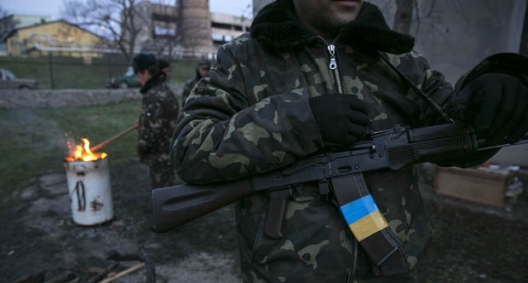
A Better Army and Economy Will Help Kyiv Stay Independent of Moscow
As the United States and NATO search for the right ways to oppose Russia’s seizure from Ukraine of the Crimean Peninsula, policymakers should note a surprising industrial fact: Ukraine is the world’s fourth-largest arms exporter, having sold more than $1.3 billion in weapons and related products in 2012 (the latest year for which the Stockholm International Peace Research Institute has published its annual estimates).
This suggests a long-term policy tool that the West can use to help Ukraine build its frail economy and upgrade its own military as a better bulwark against Russian coercion. That is, help the Ukrainians modernize their (almost entirely state-owned) arms industry and their national defenses.
Related Content
|
Ukraine’s biggest military brand name is Antonov, the Kyiv-based builder of the world’s largest transport aircraft, which NATO uses to move its outsized loads in and out of Afghanistan and other places. Zorya Mashproect, in the Black Sea ship-building center of Mikolaiv, builds gas turbines for ships, including those of the Russian navy. But Ukraine’s arms business is substantially the heavy kit of ground combat, including T-84 tanks, armored personnel carriers, rocket launchers, howitzers, grenade launchers, anti-tank missiles, and machine guns.
Ukraine for years has sold its weapons to anyone – a repeated headache for governments trying to manage or end wars and arms races. In 2007, it secretly shipped 33 refurbished T-72 tanks to Sudan’s south amid that country’s civil war. In 2000 and 2001, Ukrainian arms dealers sold 12 Kh-55 cruise missiles to Iran, despite the UN embargo on such sales.
For all that industrial muscle, Ukraine has bought little new weaponry, or otherwise modernized its own forces. The country’s total military spending in 2012 was only about $1.9 billion. According to Sam Perlo-Freeman of SIPRI, the government is actually spending more on military pensions than on the active force.
Russia’s seizure of Crimea leaves unclear exactly what kind of Ukraine will emerge from this crisis – and when. But as analyst Mark Safranski noted last week at War on the Rocks, Ukrainians are likely to respond to Russia’s assault by stepping more firmly than ever toward the European Union and the West. Governments and defense companies in the transatlantic community should begin thinking now about how they might engage Ukraine’s government and defense industry to mutual, long-term, strategic benefit.
To see the possibilities, observe how Ukraine’s factories beat some of the world’s leading land warfare equipment suppliers in big sales to countries like Thailand and Iraq. For such middle-income countries, Ukrainian industry can offer reliable weapons at affordable prices. Its labor costs are low, and surplus inventories (at least for now) are huge. But for a First World fight, its products need a little boost. As NATO armies have learned over the past twenty years, old metal can be re-bent and stuffed with the latest electronics. The Israeli firm Elbit has made a particularly good business of upgrading old Soviet equipment – just the relatively inexpensive modernization that Ukraine’s own army needs.
Once Ukraine’s government and its arms companies are past this crisis and can begin contemplating the future, North American and European governments should engage them with policies like these:
- Quick action on export licenses. When Kyiv comes looking for the nuts, bolts and technologies to modernize its industry and its forces, governments should respond. While the West may still ponder the risk of Russian sympathizers in Ukraine passing technology on to Moscow, the current crisis may help reduce that hazard.
- Encouragement for western defense companies to work in Ukraine. Companies in the West should plan to get involved with the Ukrainian firms. As Byron Callan of Capital Alpha recently wrote, just “forget about notions of Ukraine in 2015–17 buying F-16s or F-35s.” The solutions must be cost-effective on an Eastern European scale. Companies such as Boeing and Sikorsky learned how to do this years ago, working with post-communist enterprises in Poland and the Czech Republic.
- Renew and expand NATO-members’ lease of Antonov transports. A dozen NATO member states, with a couple of non-NATO partners, have for a decade leased six massive Antonov An-124-100 cargo jets – some supplied by Antonov, and some by a Russian company, Volga Dnepr Airlines. When this contract (the Strategic Airlift Interim Solution, or SALIS) expires at the end of the year, the states should consider expanding it, and should re-direct it to purely Ukrainian providers.
None of this can begin actively amid the insecurity of the Crimean conflict. But as soon as it’s practical, upgrading industry in the East with help from the West should again be a strategic priority, as it was following the collapse of the Soviet Union. This time, the work is not about defense conversion or a peace dividend. It’s about building strong institutions in Ukraine that in the future can help deter such blatant violations of a European country’s territorial integrity.
James Hasik is a senior fellow on defense issues at the Atlantic Council’s Brent Scowcroft Center on International Security.
Image: Tape in the colors of the Ukrainian flag is seen on the weapon of a Ukrainian serviceman standing guard at an air base located in the village of Lyubimovka near Sevastopol, in Crimea, March 6, 2014. REUTERS/Baz Ratner
